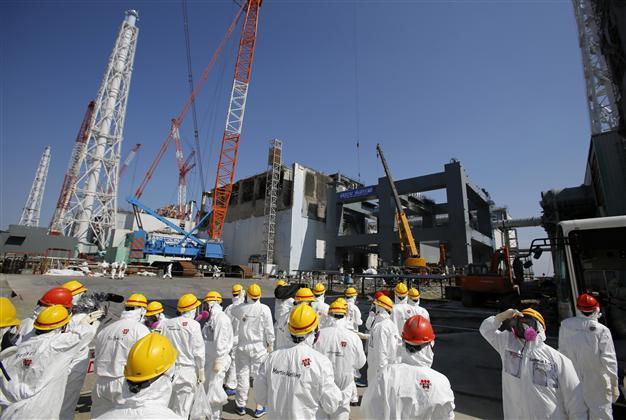Used fuel cooling system down at Fukushima: TEPCO
TOKYO - Agence France-Presse

AP Photo
One of the systems keeping spent atomic fuel cool at the Fukushima Daiichi nuclear plant stopped on Friday, its operator said, the latest glitch to hit the crippled site.
Tokyo Electric Power (TEPCO) said an alarm sounded at the facility at 2:27 pm (0527 GMT), and technicians soon confirmed that the cooling system was not working for the pool attached to reactor 3.
"We have no information at hand about the cause," a TEPCO spokesman said in Tokyo.
But engineers expected to be able to restore the system by the end of the day, he added.
Although the breakdown is not thought to be immediately dangerous, it served as a reminder of the precarious state of the Fukushima plant, more than two years after it was hit by the giant tsunami of March 2011.
Last month, a wide power outage at the plant stopped cooling systems for four pools storing spent nuclear fuel after a rat interfered with the electrics.
At the time, it took nearly 30 hours for TEPCO to fully fix the problem.
TEPCO and the government said in December 2011 that the reactors were "in a state of cold shutdown" -- a phrase carefully chosen, commentators said, to imply normality in units that were so broken that standard descriptions did not apply.
Authorities insist they are getting on top of the problem and the reactors are not leaking significant amounts of radiation.
But the plant, which TEPCO and the government plan to dismantle over the next four decades, is kept stable only with makeshift systems to supply power, cool reactors and clean radioactive materials from water used as coolant.
As of 2 pm on Friday, the temperature inside the pool affected by the latest glitch stood at 15.1 degrees Celsius (59.18 Fahrenheit), well below the safety limit of 65 degrees Celsius (149 degrees Fahrenheit), TEPCO said.
Equipment measuring radioactivity, placed in and around the Fukushima plant, has shown no new abnormality related to the latest trouble, the company added.
Fukushima was the site of the worst nuclear crisis in a generation. Reactors went into meltdown and spewed radiation over a wide area, forcing tens of thousands of people from their homes and polluting farmland.
Although the natural disaster that spawned the emergency claimed around 19,000 lives, no one is officially recorded as having died as a direct result of the atomic catastrophe.
However, pressure groups like environmental campaigners Greenpeace maintain the long-term health effects for people in the area are being vastly under-estimated by a government they say is in hock to a powerful nuclear industry.
